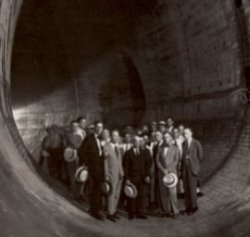MSD inherited a system that had grown slowly and not very promptly in response to problems. When it came to sewers and drainage, Louisville had never caught up.
A large part of the problem was the city’s original location, in pond-dotted bottomland along the Ohio River. Established during the Revolutionary War, Louisville remained a slow-growing frontier town for nearly a generation.
Growth accelerated as the 19th Century began. The population nearly quadrupled between 1800 and 1810, to a bustling 1,357 people. The first newspaper was established in 1801, the first theater in 1808, and the first church in 1809.

In 1805, at Louisville’s request, the state legislature passed the "Hog and Pond Law." Its aim: to ban free-roaming pigs from the muddy dirt streets, and to drain the water from the stagnant and stinking ponds. But the law made no provision for raising money for the drainage work, and little was done.
It took a crisis to bring action: the malaria epidemic of 1822. One-fourth of the population was stricken; at least 140 died. Louisville, where sickness was already common, earned an unwanted nickname: "The Graveyard of the West."
The roles of mosquitoes, microscopic parasites and bacteria were unknown at that time, but people suspected the ponds. Experience had taught settlers throughout the west that wherever there were ponds and swamplands, people became sick. In 1823, the Jefferson Pond Drainage Company was formed, this time with financing: a $60,000 lottery approved by the state legislature.
A town engineer was hired to direct the drainage effort. Ditches were dug, land was filled, and by the end of the decade, most of the ponds were gone. For decades to come, the drainage ditches and local streams would serve as the city’s sewer system.
Sometime before 1850 Louisville’s first underground sewer was built. Most likely it was the Second Street sewer, from Jefferson Street north to Beargrass Creek, which entered the river at Fourth Street then. This first underground sewer was basically a ditch lined with stone and covered with stone slabs.
By 1850, Louisville had become the tenth largest city in the nation, with more than 43,000 people. It was a major port, with a thriving boatyard industry. It had a new university, was building a Catholic cathedral, and was organizing the Louisville and Nashville Railroad. Its streets had been lighted by gas for more than a decade; businesses and wealthy homes had interior gaslights. Prestige suburbs were developing in the rural area south of Broadway. But the underground sewer system had reached a length of only one and one-half miles.
Perhaps the biggest "sewer" project of the next decade involved enclosing the old channel of Beargrass Creek from near Fourth Street east to First. The Beargrass Creek Cutoff was dug along Story Avenue, routing the creek directly to the Ohio River and bypassing downtown. The old channel was enclosed, creating a sewer.
By 1860, Louisville’s population had grown to more than 68,000, but the underground sewer system was less than two miles long. That year brought a major improvement that would dramatically increase the need for sewers: the Louisville Water Company began operations, pumping water from the river to the downtown area. Soon there was much more water available, and much more to be disposed of. By the end of the century, the population had grown to more than 204,000 — and the sewer system had grown to more than 99 miles.
Problems were mounting, however. The underground sewers still led directly to the ditches, the streams, and the river. Beargrass Creek was a stinking mess, polluted with wastes from the Butchertown slaughterhouses and from the increasing number of sewer lines that dumped their loads into it. The city was building up to four miles of new sewers per year, but construction lagged far behind the need.
In late 1906 the voters approved a $4 million bond issue to build new sewers; the work was to be overseen by a newly created Commissioners of Sewerage. Over the next seven years the commissioners would oversee the design and construction of about 54 miles of major sewer lines. The work included the city’s first interceptor sewers, designed to "intercept" the sewer lines leading to Beargrass Creek and to carry the water directly to the Ohio River. It also included the first stretches of concrete channel for Beargrass Creek.
The commissioners went out of business in 1913, but the city used a windfall to continue building sewers. Louisville Gas and Electric Company was formed that year in a consolidation of all the major gas and electric utilities; the city sold its stock in the old Louisville Gas Company for $1,387,500 and used the money for the sewer program.
The money ran out in 1915, the year after World War I began. Sewer construction lagged again, falling further behind the need. The United States entered the war in the spring of 1917, and Camp Zachary Taylor was quickly built at the south edge of Louisville to train new troops. The camp included a network of sewers, some made of wood, that would trouble the area for generations to come.


